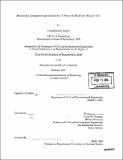Measuring congestion and emissions : a network model for Mexico City
Author(s)
Amano, Yasuaki Daniel, 1978-
DownloadFull printable version (7.746Mb)
Other Contributors
Massachusetts Institute of Technology. Dept. of Civil and Environmental Engineering.
Advisor
Joseph M. Sussman.
Terms of use
Metadata
Show full item recordAbstract
Congestion is a major problem for the major cities of today. It reduces mobility, slows economic growth, and is a major cause of emissions. Vehicles traveling at slow speeds emit significantly more pollutants than vehicles traveling at free flow speeds. It is therefore important to determine the extent of congestion in a city, and its impact on the environment. This thesis focuses on congestion in the Mexico City Metropolitan Area. Mexico City is one of the largest cities in the world, and faces severe levels of congestion and emissions. Although much of the transportation trips are made by high capacity modes such as buses and colectivo microbuses, a growing population and increasing automobile ownership rate will further exacerbate the city's mobility and environment. In order to measure the level of congestion in Mexico City, a network model was built. Combining data from a 1994 origin destination survey and the 2000 census with a digitized roadway network, we were able to determine the state of vehicle speeds on roadways throughout the city. This speed distribution was then used in the MOBILE6 model to estimate the total emissions from road based transportation sources. The network model was also used to study the extent of congestion and emissions for various future infrastructure projects. An analysis was done for a year 2025 growth scenario, where Mexico City continues to grow in population and size. The impact of two infrastructure improvements on congestion was also studied. The results of the model show that while it is a useful tool for studying congestion on a citywide scale, the effects of local infrastructure changes cannot be accurately modeled. Further work on improving the model may yield improved results on a greater level of detail.
Description
Thesis (S.M. in Transportation)--Massachusetts Institute of Technology, Dept. of Civil and Environmental Engineering, 2004. Includes bibliographical references (p. 57-58).
Date issued
2004Department
Massachusetts Institute of Technology. Department of Civil and Environmental EngineeringPublisher
Massachusetts Institute of Technology
Keywords
Civil and Environmental Engineering.